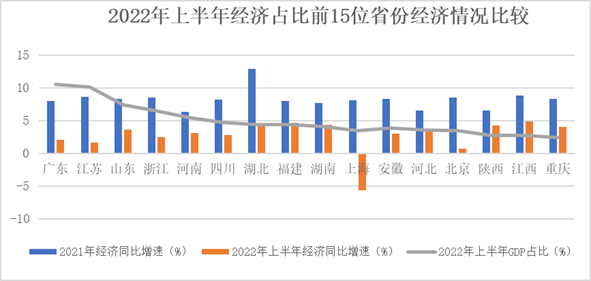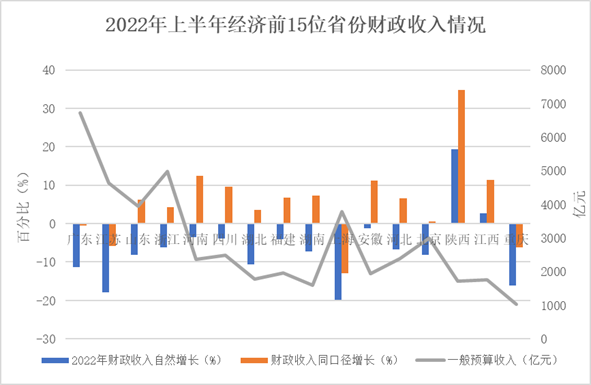At a recent conference in Shenzhen, Chinese Premier Li Keqiang emphasized that provinces of major economic significance need to "shoulder greater responsibilities", and make due contributions to economic growth and fiscal revenue. Among the six of such provinces participating in the conference, except for Henan and Sichuan which belong to the central and western provinces, the rest like Guangdong, Jiangsu, Zhejiang, and Shandong are relatively developed areas along the southeastern coast of the country. Since the beginning of this year, the request that the major economic provinces to "shoulder greater responsibilities" has been put forward many times by the central government, requiring both the central and local initiatives to be brought into play. The Politburo meeting in July re-emphasized that "provinces with large economies should take the leading role, and provinces that fulfill the conditions should strive to achieve the expected goals of economic and social development". Researchers at ANBOUND believe that this actually reflects two problems. First of all, this implies that the severe economic situation in China, and it is still difficult to solve the problem of stable growth solely by relying on central-level policies. Instead, local initiative is required. Secondly, the eastern region's stable growth has slowed down. Provinces like Guangdong, Zhejiang, Jiangsu, as well as Beijing, Tianjin, Shanghai and other municipalities, have been continuously affected by the COVID-19 outbreaks this year. With their economies being impacted, this has become the main factor behind the overall economic slowdown in the country.
For the specific provinces to assume greater role, these provinces actually need to maintain the economic recovery to the "normal range" the soonest time. Li noted that the six major economic provinces accounted for more than 40% of the country's total economic output and employment. Such provinces therefore, should take the lead, tap their own policy potentials, ensure that market entities stabilize the economy, and stabilize the employment of local and migrant workers, according to the Premier. Maintaining economic growth in a large economic province not only has a positive effect on the stability of the local economy, but also drives the economic demand of other provinces and cities as well. If the economic development momentum of the larger economic provinces is wanting, this will increase the employment pressure of the labor force in the central and western regions. This, in turn, will reduce and weaken the development momentum and consumption capacity of the central and western regions as well. For this reason, the Chinese central government pays special attention to the economy of these economic powerhouses, hoping that they will be the pillars in stabilizing the country's economy.
Figure 1: Economic Growth of the Top 15 Provinces in the First Half of 2022

Plotted by ANBOUND based on online data
When it comes to the issue of the provinces that need to "shoulder greater responsibilities", the focus of the conference is on the financial contribution. The Premier pointed out that stabilizing the economy is by itself, stabilizing financial resources. He mentioned that the four coastal provinces among the six provinces contributed more than 60% of the net turnover to the central government and needed to complete the task of financial turnover. "The local governments should tighten their belts, put existing assets to better use, maintain a balance between revenue and expenditure, and guarantee fiscal spending in ensuring people's livelihoods", Li is reported to say. He also noted that these provinces should locate ways to boost consumption. At the same time, the Premier requested that the debt limit space for special bonds to be revitalized, and with the utilization of policy-based development financial tools, so as to expand effective investment and drive consumption.
Researchers at ANBOUND are of the opinion that the focus of fiscal stability this year will be these economically significant provinces achieving net tax payment. Since the beginning of this year, due to the COVID-19 pandemic, as well as tax cuts and fee reductions, the decline of land income and other factors, China's fiscal revenue this year has fallen sharply. According to data from the Ministry of Finance, the national general public budget revenue in the first half of this year was about RMB 10.5 trillion, down 10.2% in natural caliber, but 3.3% after deducting the value-added tax credit and refund factor. Among them, the central general public budget revenue was about RMB 4.8 trillion, an increase of 1.7% after deducting the factor of tax rebates, and a decrease of 12.7% according to the natural caliber.
At the local level, other than a few resource-based provinces such as Shaanxi that have seen the income increased significantly, most others with the highest economic share have experienced a decline in income. Among them, the developed eastern provinces and cities that have been hit hard by the novel coronavirus outbreak have suffered a significant impact. This naturally affects the tax payment of the major financial provinces, which in turn, affects the central fiscal revenue. Under this circumstance, in order to alleviate the local financial predicament, the central government have utilized trillions of yuan to increase the scale of transfer payments to local governments (about RMB 10 trillion). Therefore, the central government's revenue and expenditures are facing the problem of widening gaps.
Figure 2: Fiscal Revenue of China's Top 15 Provinces in the First Half of 2022

Plotted by ANBOUND based on online data
If the economic powerhouse provinces are having difficulty, not only will the central fiscal revenue be under pressure, but other regions with greater fiscal revenue and expenditure pressure will face a larger gap. This is also why the central government has repeatedly asked the major financial provinces to assume greater responsibilities. It appears that the pressure on fiscal revenue and expenditure is not only reflected in local problems, but has spread upward to the level of central-level finance. This reflects the severe situation in fiscal revenue, as well as expenditure problem.
However, the current regional fiscal imbalance and the increasing pressure on the central and local fiscal deficits may be difficult to tackle merely by relying on the major provinces to "shoulder more responsibilities". By doing so, China's central government hopes to expand financial resources while stabilizing leverage through tapping into the potentials of these provinces, as well as through and cross-cyclical adjustment. For this reason, it requires the local governments to "explore the limit space of local debt stock and utilize policy development financial tools" for effective investment. However, due to the different debt limits in various regions, some provinces with heavier debt burdens have strong financing needs, yet they are with less spaces. While the debt pressure in Northeast China is lesser, there is the issue of limitation. Under the state of fiscal imbalance, adjusting the local debt limit across provinces and allocate policy-based financial instrument resources remains a relatively complicated issue.
Noteworthily, some economically developed areas in the eastern part of the country have been greatly affected by the continuous impact of the COVID-19 outbreaks. Judging from the current situation, their recovery process remains slow, even with a tendency to decline. In addition, they do not possess solid foundation for stable growth, and they require policy support. If the Chinese authorities maintain the scale of net fiscal and tax payment, this may increase the burden on the economically prominent provinces. As local areas have insufficient financial resources, not only these provinces need to contribute more, other regions too will have to undertake certain measures. As pointed out by ANBOUND, there is still room for leverage in the central finance. Under the circumstance of increasing local debt burdens and serious fiscal imbalances, leveraging the central finance will not only help the northeastern provinces to recover fast, but will also greatly ease the current overall fiscal pressure. The foremost priority of the economically prominent provinces and developed coastal areas is to stabilize the economy and improve the continuous downward trend of the economy.
Final analysis conclusion:
China's central government has been asking the developed eastern regions and provinces with economic prominence to assume greater responsibilities, with the objective of stabilizing the country's economy. This actually reflects the unprecedented pressure on its economy and finances, which not only requires the support of the central government's policy, but also the "contribution" of these provinces. However, when the eastern region of China has been severely hit by COVID-19, its economic recovery becomes slow, with their growth foundation being less than solid. Hence, the space for them to play a role is rather limited. As things stand, they also require more policy supports to stabilize the economy and financial resources.
